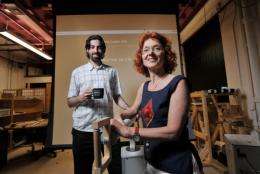The risk of carrying a cup of coffee

Object manipulation or tool use is almost a uniquely human trait, said Dagmar Sternad, director of Northeastern’s Action Lab, a research group interested in movement coordination. “Not only does it require certain cognitive abilities but also distinct motor abilities.”
Simply moving one’s own body, for instance by directing a hand toward a coffee cup, requires the organization of various physiological systems including the central and peripheral nervous systems and the musculoskeletal system.
Once the hand grasps and picks up the cup, the questions become even more complicated. What if the cup is filled with liquid? At this point, the complexity of the control problem balloons — the presence of the liquid introduces nonlinear fluid dynamics with the risk of a spill because of the inherent variability in one’s movement.
Sternad, a professor of , biology, electrical and computer engineering and physics and postdoctoral researcher C.J. Hasson are interested in how we adapt our movement strategies when interacting with dynamic objects in the environment.
In a recent paper published in the Journal of Neurophysiology, Hasson and Sternad explored the question by looking at the everyday task of manipulating a cup of coffee. They show that how we adapt our movement strategies is directly related to the amount of variability and reliability in our surroundings and ourselves.
“Because we’re humans and not machines, we’re noisy and variable,” said Hasson. “We can’t expect that a movement will unfold exactly as we planned it.”
For the study, 18 healthy participants visited the Action Lab to play a video game, wherein they attempted to move a virtual cup filled with virtual liquid across a large video screen. Instead of a normal video-game controller, subjects moved the virtual cup by grasping a manipulandum — a large robotic arm. Similar to the real-life scenario, the robot simulated the forces one would feel from the weight of the object and the sloshing of the liquid in the cup.
They asked participants to move the cup across the screen within a comfortable time of two seconds, a task for which there is an infinite number of possibilities. You could move fast for one second and slow for one second, slow for a half second and then fast for one and a half seconds. The team hypothesized that participants would naturally adapt a safe movement strategy with practice — and they did.
But the most intriguing result, said Hasson, was that the size of each participant’s safety margin —or how close they let the liquid get to the edge of the cup — could be predicted by how variable they were in their movements. Those with more variability tended to adapt a “safer” strategy with a larger safety margin.
“If you have a large safety margin and I move with a small margin, the question is, ‘Why am I more risky than you?’” Hasson said. “Well, you may find that I am much more consistent in my movements, so I don’t need a big safety margin. If you’re more variable, you need a larger safety margin.”
The results have implications in assessing elderly patients and patients of motor disorders such as cerebral palsy. “If variability determines the movements that you do, maybe that’s an intervention point,” said Sternad.













